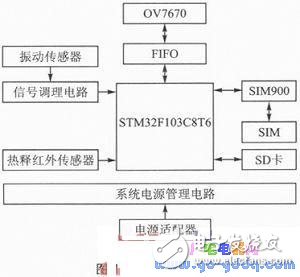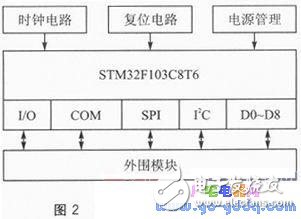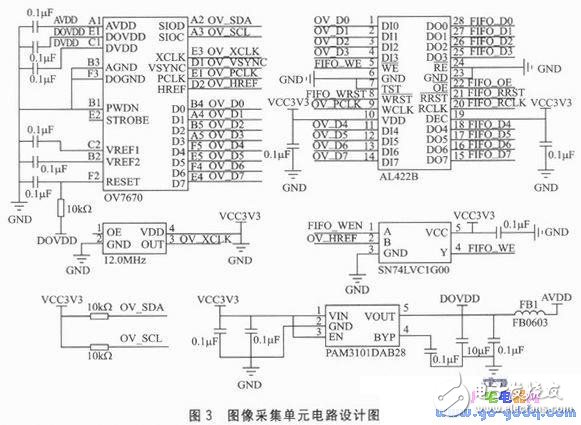A real-time security system with a 32-bit ARM microprocessor STM32F103C8T6 as the control core, plus a vibration sensor and a pyroelectric infrared sensor is designed. When the system is in working state, it can monitor in real time whether someone enters the monitoring area and realize automatic sending of MMS alarms. The system uses the micro image sensor OV7670 to obtain image information, and preliminarily processes the image, and then uses the GPRS module SIM900 to send the MMS to the designated mobile phone, and saves the acquired image data to the SD card. The experimental results show that the system works stably and achieves the design goals.
In recent years, with the rapid advancement of urbanization in China, people's living environment has been greatly improved, and various types of valuables in the home are also increasing. Because the floating population of the city is relatively complicated, home security has become a very important issue for people. There are many plans for home security research at home and abroad. These solutions basically use the high-performance ARM9 or ARM11 platform running the embedded operating system, and the peripherals are equipped with a variety of high-end sensors. These solutions cost a lot. This paper introduces a home real-time security system based on a low-cost 32-bit ARM platform as a control core. It provides a real-time security solution with a more practical design and lower cost, which can satisfy most families. The need for home security.
1 system structure
It can be seen from Figure 1 that the modular design concept of the system makes full use of mature technology and module products, which is beneficial to reduce the design difficulty and overall cost. The system adopts low-ripple high-efficiency 5 V switching power supply as the working power supply. After the voltage is processed by the multi-channel power management unit, the system supplies power to each module of the system to ensure good anti-interference performance. The control core of the system is STM32F103C8T6, and the vibration sensor is SW-180. It is an interrupt information input unit. The user can install it in a suitable position and is responsible for detecting vibration signals. The system frame diagram is shown in Figure 1.

The model of the pyroelectric infrared sensor is HC-SR501, which is also a one-way input unit. The sensor can accurately detect the human body moving signal within the range of 5 to 7 m at 100 °C, and feedback the signal to the system control core in real time. The image sensor OV7670 is connected to the control core STM32F103C8T6 after passing through the data buffer FIFO, which can reduce the speed requirement of the microprocessor and reduce the burden on the system.
After the image information enters the microprocessor, preliminary processing and format conversion will be performed, and the obtained JPEG format image is sent to the designated mobile phone through the GPRS module SIM900 in the form of MMS. Once a suspicious person enters the house, the system will be triggered and automatically capture the live photo, send a multimedia message to remind the user, and then save the photo to the system's own SD card for review.
2 hardware design
2.1 system core unit
The system core processor STM32F103C8T6 uses a high-performance ARM Cortex-M3 32-bit RISC core operating at 72 MHz with built-in high-speed memory (64 KB flash and 20 KB SRAM), rich enhancement I/O ports and connectivity to two Group peripherals for the APB bus. It consists of two 12-bit ADCs, three general-purpose 16-bit timers and one PWM timer, as well as two I2C bus and SPI interfaces, three USART interfaces, one USB interface and one CAN bus interface. The STM32F103C8T6 operates from 2.0 to 3.6 V and is available in an LQFP48 package. The LDO is used in the system to convert the 5 V supply to 3.3V to power it.

Figure 2 shows the clock circuit and reset circuit. The SD card communicates with the core processor through the SPI interface. The vibration sensor and the pyroelectric infrared sensor are connected through the interrupt I/O port. The SCCB interface of the image sensor OV7670 is connected to the I2C of the core processor. Bus interface, GPRS module SIM900 communicates through serial port 1.
2.2 Image acquisition unit
The OV7670 is a 30W pixel COMS image sensor from OmniVision. It features small size and low operating voltage, and provides all the functions of a single VGA camera and image processor. The system is controlled by the I2C bus, and can output 8-bit image data of various resolutions such as full frame, sub-sampling, and window. The product's VGA image can reach up to 30 frames/s. Users can control image quality, data format and transmission method. OmniVision Image Sensors use unique sensor technology to improve image quality and reduce sharp and stable color images by reducing or eliminating optical or electronic defects such as fixed pattern noise, tailing, and floating.

The 12 MHz active crystal is designed in the circuit of Figure 3 to generate a 12 MHz clock as the XCLK input to the OV7670. PAM3101DAB28 is used to provide stable 2.8 V working voltage to the analog circuit inside OV7670, and the I/O working voltage also uses this set of 2.8V power supply, so the LV7670's own LDO can work normally and automatically provide the core part of OV7670. 1.8 V power supply.
The system is designed with a FIFO chip AL422B, which has a capacity of 384 KB, enough to store 2 frames of QVGA image data. Because the FIFO is used as the data buffer, the data acquisition burden of the system is greatly reduced. The designer only needs to care about how to read the FIFO data interface. It is no longer concerned with how the data of the OV7670 is collected and how it is transmitted to the FIFO. Image acquisition can be achieved without even having to care about CMOS control and timing relationships.
2.3 Vibration sensor unit
Power Breadboard,Breadboard Power Supply,Breadboard Power Supply Module,Breadboard Power Module
Cixi Zhongyi Electronics Factory , https://www.zybreadboard.com